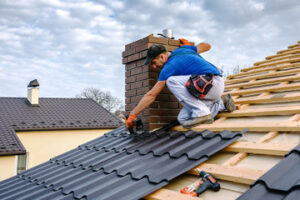The roof plays a crucial role in a home, protecting it from weather elements and enhancing its structural integrity. The design of a roof is determined by many factors, including the material and slope.
In the case of a new roof installation, contractors must prepare the site before they begin work. This includes covering surrounding landscaping with tarps and using magnetic tools to collect metal pieces of debris from the lawn. Visit Website to learn more.
Asphalt shingles provide a robust protective barrier against the elements. They are affordable and easy to install, but they require regular maintenance to prolong their lifespan. If you’re planning to install a new roof, there are three main types of shingles to choose from: strip, laminated, and architectural. Each type offers a different color, pattern, and texture to enhance the appearance of your home.
Before you start laying shingles, make sure to lay a layer of underlayment over the roof decking to prevent water infiltration. This material is available in a variety of options, including roofing felt and synthetic underlayment. It’s important to follow the manufacturer’s recommendations when determining the type and quantity of underlayment you need. Underlayment should be installed in overlapping rows and around roof penetrations like chimneys and vents. It should be overlapped by at least two inches, and ice and water protection membranes should be installed over it.
When shingle installation is complete, it’s crucial to clean the area around the shingles and dispose of any debris. It’s also important to install ridge vents and other ventilation systems to avoid heat and moisture buildup. This will extend the life of your shingles and prevent water leaks.
In addition to their durability and affordability, asphalt shingles have several other advantages over other roofing materials. For example, shingle roofs provide good insulation and noise reduction. In addition, the granules on asphalt shingles are fire resistant and help to reduce the risk of a house fire.
Another advantage of an asphalt shingle roof is its resistance to algae growth. A buildup of algae can cause your roof to look dirty and dingy, but the algae-resistant features in some shingles can help prevent this from occurring. Many homeowners find this feature to be extremely helpful. With proper care, asphalt shingles can last up to 40 years. In fact, some shingles even come with a lifetime warranty. The key is to make sure you are using a quality brand and following the manufacturer’s recommendations for the best performance. IKO shingles, for example, have built-in algae resistance and offer a Class 4 impact-resistance rating that can lead to a lower insurance premium in some cases.
Metal Roofs
Metal roofs are a popular option for home and business owners due to their durability, energy efficiency, and pristine look. They can provide a modern aesthetic and increase the value of a property. However, like any other roofing material, they require regular maintenance to preserve their longevity and appearance. DIY metal roof installation can be a rewarding and cost-effective project with proper planning and execution.
To install a metal roof, the first step is to establish a budget for materials and equipment. This can be done by calculating the price of the panels, any necessary metal trim, underlayment, and accessories. It is also important to consider any additional expenses such as the cost of tools and/or equipment rental. This will help ensure that the project is completed within your desired budget.
Once you have established a budget, the next step is to decide which type of metal to use. There are four different metals that can be used for roofs: aluminum, steel, galvalume, and copper. Each has its own advantages and disadvantages, so it is important to choose the right metal for your specific needs. For example, if you live near the ocean, an aluminum or galvalume metal roof will be resistant to corrosion from salty sea air.
The final step is to prepare the site for installation by removing any existing shingles and debris from the roof. This will create a flat surface for the installation of the metal panels. It is also important to clear the area of any obstructions such as chimneys, vents, and skylights. The roof must be thoroughly inspected for any potential problems, such as leaks, damage, or structural issues.
In addition to the initial investment, a metal roof offers several other ROI-boosting benefits. They are extremely durable and can last up to twice as long as an asphalt shingle roof. Additionally, they can reduce cooling costs by up to 40%.
While a metal roof may seem expensive at first, it is an excellent long-term investment that will pay off over time. In addition, homeowners can often receive insurance discounts for metal roofs.
Slate Roofs
Slate roofing offers the perfect blend of natural beauty and longevity, making it a popular option for homeowners. However, it can be difficult to install, and requires a lot of patience and attention to detail to ensure your roof looks its best.
It is also more costly than most other roofing materials, but it will last significantly longer and will require far less maintenance over time, making it a great long-term investment for your home. Fortunately, slate roof installation methods are improving all the time, and now it’s easier than ever to enjoy the beauty of a natural slate roof at an affordable cost.
A slate roof is a complex system of interlocking tiles, each with its own color and texture. The colors are derived from the minerals in the rock, with hematite producing purple tones and chlorite creating green tones. Depending on the mineral composition, and the amount of oxidation or weathering, slates can range in tone from unfading black to semi-weathering gray to unfading green.
The function of a slate roof is to protect the structure below, shed rain and snow, resist wind and other loads and provide ventilation. Slates are installed in a variety of patterns and sizes, which result in stunning roofscapes that have become landmarks of modern architecture. A good design professional or roofing contractor can help you choose the right pattern for your home. The pattern must be compatible with the type and grade of slate you select, as well as with the construction details.
A good slate roof must be constructed to be water tight. This is achieved by a minimum required head lap and by using properly installed lead flashings. There are two things that keep water from penetrating a slate roof: the slates and the flashing. If either of these elements are not done correctly, the roof will leak.
Unlike other roofing materials, slate is not driven into place by nails or screws. Instead, slates are nailed to the decking with copper nails. The nails are not drilled through the slate, but rather through an appropriate metal flashing and into the roof decking. All nails must be of the proper gauge to prevent damage to the slates, and all holes are hand holed by a skilled craftsman. The nail heads are then sanded flush with the surface of the slate and then covered with copper caulk. Rakes, valleys and ridges must be cut to length using a slate cutter. These tools have a reinforced handle with a punch that makes holes for the nails. Each hole is a little over 2 inches in diameter.
Roof Repairs
Your roof is your home’s first line of defense against the elements. It keeps your appliances, valuables and structural supports safe from water damage. But over time, it’s not uncommon for your roof to require repair.
Most minor repairs are fairly quick to complete. Replacing missing shingles and fixing flashing are typical fixes that most roofers can handle in one to five hours. More involved repairs like repairing leaks, addressing a sagging roof, or improving ventilation can take multiple days to complete.
Roof leaks are common and can be caused by damaged or missing shingles, ice dams, and poor flashing. During roof repairs, your roofer will ensure all areas are properly sealed to prevent future moisture problems. They will replace damaged or torn shingles and add additional shingle layers where needed. Then, they will install flashing at valleys and around dormers, chimneys, wood stove pipes, vents, and hip roofs. They will also check the sheathing and make any necessary repairs.
Aside from replacing shingles, you can upgrade your roof with new vents for increased attic ventilation, or a skylight for natural light. You can also add insulation to improve energy efficiency, or a gutter system for added protection.
When it comes to roof repair, you should know that DIY projects may void your warranty, and it’s also not a good idea to try to address major damage on your own. If your roof is in major disrepair, it’s best to talk with a local roofer and discuss what materials and labor are feasible within your budget to achieve a quality result.
Before the roofing company arrives, prepare your home for their work by moving any outdoor items away from the roof. Cover the surrounding landscaping with a tarp to protect it from falling debris. If you have attic storage, be sure to move it out of the way so you’re not forced to clean up dust and other roofing debris during your reroofing project. Also, be sure to close any gates and fences so animals or children don’t wander into the area while the roofers are working.




